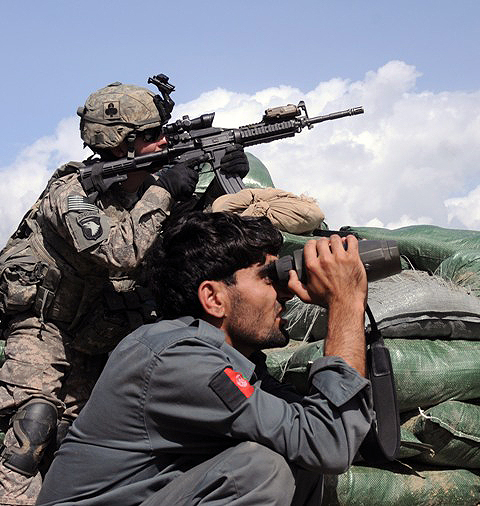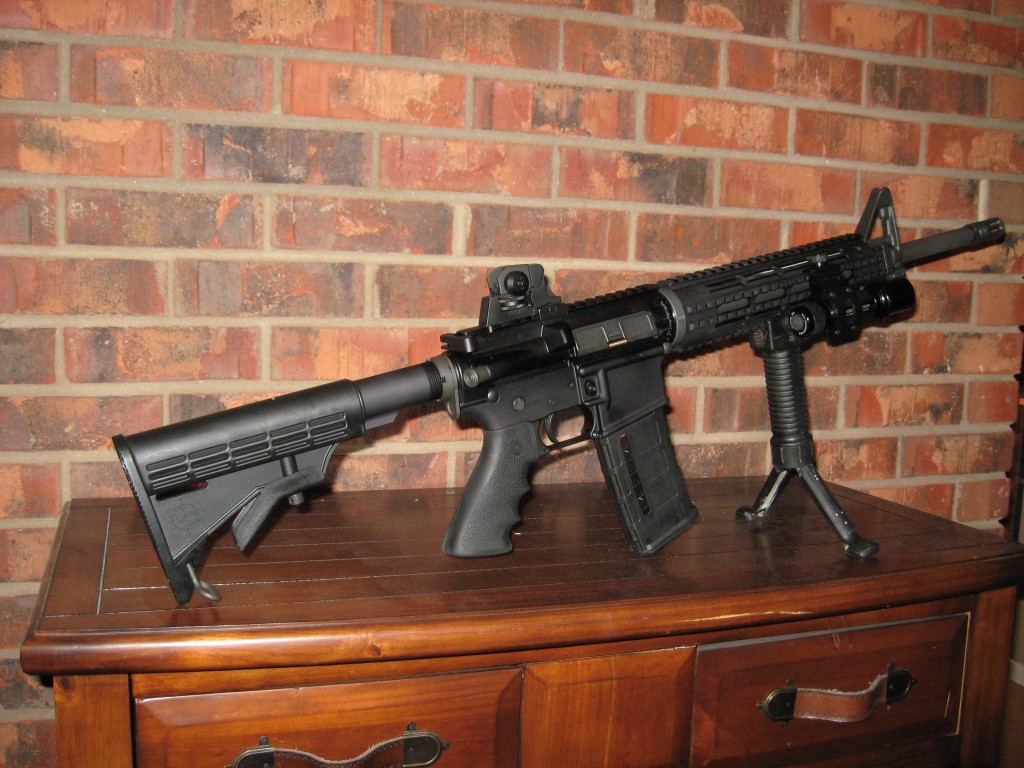In The Five Hundred Meter War I linked a report at Global Post by James Foley, who also blogs at A World of Troubles. Please spend the time to read my analysis as context for my criticism of another article below, and also visit Jim’s web site. His prose is current, salient, well-informed and well written.
Citing the same report at Global Post by Jim, Pia de Solenni writing at National Review Online’s Corner weighs in quite differently from my analysis.
Two years ago today, my brother Bruno was killed while serving in the U.S. Army in Afghanistan. Before going to Afghanistan, he’d done two other tours, including Iraq. I think just about every family member of a deployed soldier surveys the news with trepidation, worrying that it could be their loved one who’s the latest casualty or, worse, fatality.
There’s not a day that goes by that I don’t think of my brother and, naturally, there’s a poignancy around certain dates like holidays, birthdays, and today. But last Friday, as I was watching the PBS NewsHour, I was completely unprepared for the footage of soldiers in Afghanistan. Viewers were warned that the segment would contain graphic images and graphic language. That warning didn’t begin to describe the content.
Footage included a soldier getting shot in the head; fortunately his helmet slowed down the bullet. Another soldier lost part of his arm. It was as if this were just a segment from an action film or a so-called reality show. But this is real life. The wounds are not special effects. They won’t go away when the cameras are turned off. The families of these soldiers could see them in danger and being wounded. And somehow, it’s all right to expose audiences, including families, to this very real brutality being done to U.S. soldiers; but the same audiences are too fragile to hear the f-bombs that, in such circumstances, are very understandable. Real life amputations and wounds, but no profanities.
Most soldiers are far more comfortable with people hearing them use profanity than they are with having their families caused any additional worry about their safety.
The journalists who prepared the segment would argue that they’re just reporting the facts. Ah, but these are selective facts. Did they show footage asking the soldiers whether they have any positive interactions with the Afghans? Did they ask the soldiers what they think of their mission? No, and they didn’t even allow them the expression of an f-bomb. So much for hearing the soldiers in their own voices. Instead, they were exploited by the graphic images of their activities. As the saying goes, if it bleeds, it leads. But if an audience is too fragile to hear certain words, surely it’s too fragile to see real life casualties.
Segments like this convey nothing but fear and futility. They give no context to the situation. To me it seems that they undermine the concerns of our soldiers insofar as they create greater fear and anxiety for families, precisely what the soldiers don’t want, all in the name of journalism so slanted that it looks more like propaganda aiding the enemy.
Yes, I am emotionally vested. But I’ve seen very little news coverage that represents the experiences of the soldiers I’ve known, including my brother. (Our hometown newspaper was one of the few exceptions I’ve seen. They even published a letter from Bruno, written just a few days before he died, explaining why he was serving in the Army.) I have an aunt who has organized an impressive local network of volunteers to send care packages to numerous troops. Frequently, she forwards their e-mails with their stories, which are so very different from most of what the media presents.*
Regardless of what one thinks of the wars in Afghanistan and Iraq, most people agree that those who serve in the military deserve our support. They’re already risking, even giving up, their lives for our country. If certain commentators and media outlets don’t agree with this, they only have that right because we have a long tradition of military men and women who have fought and died to protect that right for them. All I’m asking is that the soldiers themselves not be exploited, whether in the broadcasting of their injuries or by causing additional anxiety and suffering to their families.
Thanks to Pia de Solenni for the heavy sacrifice of a loved one. Having deployed a son to Operation Iraqi Freedom in Fallujah at the very height of the violence in 2007, I know first hand what a heavy burden it is to bear up under the ubiquitous darkness of knowing that your flesh and blood is under fire. Friend and fellow Marine father Michael Ledeen signed his book The Iranian Time Bomb to me with these words: “To a fellow suffering father.”
I have suffered through having a son under fire, but not losing him in battle. Losing a family member qualifies one, my my opinion, to have almost any view of the particular war, and seldom do I weigh in on the griefs or even views of others who have lost loved ones, even when they disagree with my own. Andrew Bacevich is a good example. Michael Ledeen and I have discussed Andrew, and while I am certain that he seldom writes anything with which I am in complete agreement, Andrew is qualified to speak his mind. He lost a Marine son in the Anbar Province.
But Pia de Solenni’s opinion rings differently that mere commentary on a particular engagement or the overall campaign. The commentary seems to be tilting towards self censorship of certain types of coverage and commentary of the war. If something is too gruesome, too graphic, without enough prose or pictures of Soldiers and Marines walking hand in hand with indigenous peoples, then the coverage and commentary is without context.
Jim Foley is an embedded reporter who has been in theater since March. According to his most recent communication to me, he is currently in Kandahar continuing to try to get a sense of things in that AO. A quick survey of his blogroll and a longer survey of his prose shows him to be a well rounded reporter and analyst who is reporting with passion but also with balance.
No regular reader of my own posts over the last four years could possibly charge me with any sort of failure to provide context or lack of support for the troops. But I have been critical when I felt that command or strategy deserved criticism, and for this I have been dropped from blogrolls, lost traffic, and received very tersely worded letters from various readers, including some military readers (usually in the NCO ranks, and usually among those who have yet to come to terms with blogs knowing anything about the detailed goings-on within the military).
If I comment on overall strategy, that should be left to the generals in the Pentagon. If I link and comment on the rules of engagement, I am endangering the troops, regardless of the fact that they have previously been released on other web sites. If I convey original reporting because of some contact I have within the military, I am cast into the same category as the military-hating main stream media if the reporting doesn’t have that jingoistic bent to it.
But war is violence, and so that I don’t rehearse the exploits of my son, I will refer to comments made by an Army officer in Iraq.
One thing that I think many people forget about Iraq (or maybe it wasn’t reported?) is that in 2007 and 2008 we were killing and capturing lots of people on a nightly basis. Protecting the populace was A priority. When speaking to the folks back home, in order to sell the war, perhaps we said that it was the priority. But on the ground, I do not recall a single Commander’s Update Brief spending any time at all discussing what we had done to protect anyone. We were focused on punching al-Qaeda in the nuts at every opportunity and dismantling their networks. The reconcilables got the message loud and clear that they could take money and jobs in return for cooperation, or they would die a swift death when we came knocking down their doors in the middle of the night. The rest of the populace made it clear to them that they should take the offer. The only protection that the population got from us was good fire discipline so that we did not kill non-combatants. We made it clear that the government intended to win this thing and we did not send that message by delivering governance or digging wells. We shot motherf******s in the face. Pop-COIN blasphemers, your scripture is false teaching. Here is some truth:
To every thing there is a season, and a time to every purpose under the heaven: A time to be born, and a time to die; a time to plant, and a time to pluck up that which is planted; A time to kill, and a time to heal; a time to break down, and a time to build up; – Ecclesiastes 3:1-3 (KJV)
It’s time to kill.
There are many experiences, many examples, and a huge amount of context to deal with in any analysis. It isn’t possible to address all of it all of the time. On the other hand, I have repeatedly addressed the lack of force projection in the Provinces of Nuristan and Kunar, the failures at Wanat and Kamdesh, and the hard work of the men who fought in the Korengal Valley, while still calling out the bravery of the men who did our fighting in Eastern Afghanistan and covering my Marines in Helmand. Soldiers who have written me have felt the love, as well as agreed with me on many occasions as I argued for more force projection, more distributed operations, and enemy-centric tactics such as chasing the insurgents rather than just focusing on population centers.
In the case in point, I have observed that it makes little sense to send troops on patrols to be shot at, blown up, and dismembered, while the insurgents roam the hills unmolested. The insurgents aren’t being killed and the population isn’t being protected. More troops are required, and then a different set of tactics. This observation doesn’t detract from the bravery of the Soldiers who went on this particular patrol. In fact, this observation does indeed set the correct context.
Honesty and advocacy for their needs is the best context that can be given to the story. Sometimes this involves glowing reports about giving cows to widows of the war so that their sons don’t turn to the insurgency. At other times this involves saying that some tactic, strategy or doctrine doesn’t suit the need of the moment. The former is routinely accepted by those who lean right of center. The same right of center folk must learn to accept the later without calling it out as disloyalty or lack of full context. It’s what honest reporters and good military bloggers do.







